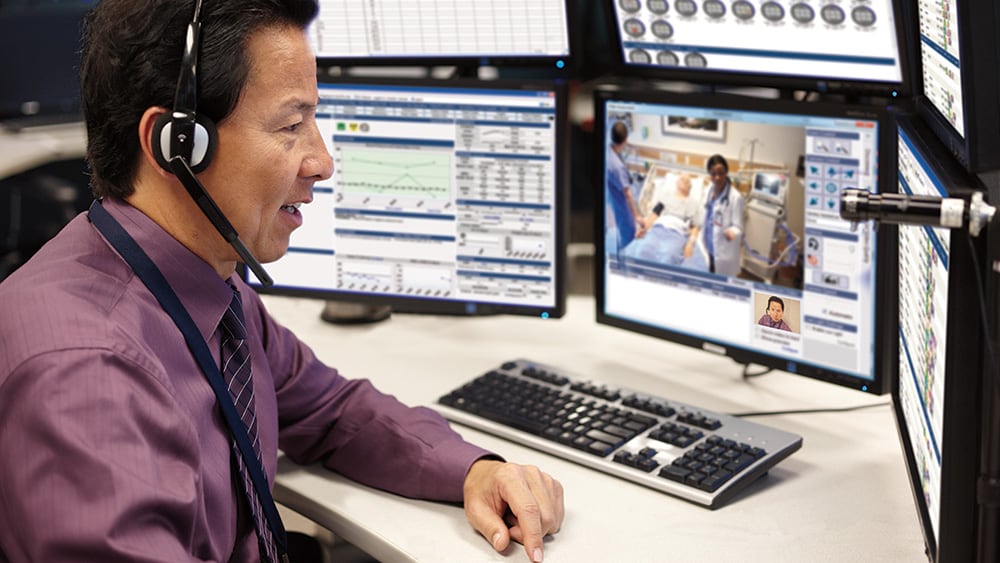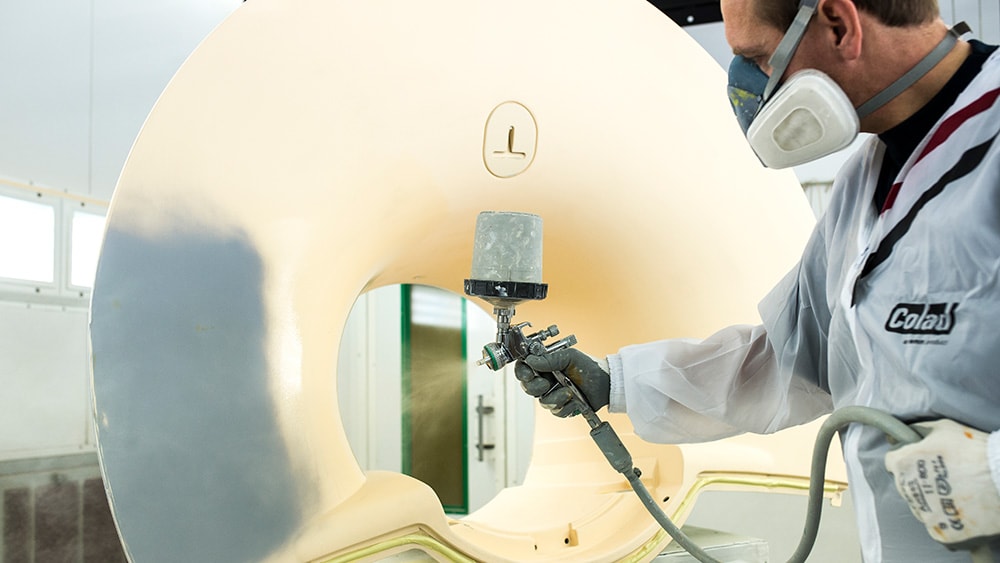10 healthcare technology trends for 2023
Jan 16, 2023 | 13 minute read
New: Discover the 10 healthcare technology trends for 2024
Workforce shortages, mounting workloads and economic pressures are challenging healthcare providers worldwide to improve operational efficiencies and innovate care delivery models. Increasingly, socially conscious healthcare leaders also recognize their responsibility to improve healthcare equality, as well as the need to reduce the sector’s carbon footprint for the preservation of the planet’s health. To help address these challenges and ambitions, here are 10 healthcare technology trends that we expect to gain further traction in 2023.

1. Addressing workforce shortages with workflow automation and AI
Staffing is healthcare leaders’ top concern, according to the Philips Future Health Index 2022 report. If we don’t act urgently, burnout and staffing shortages will continue to weaken healthcare systems. For example, in radiology, studies have shown at least half of practicing radiologists in the US experience chronic work-related exhaustion and reduced efficacy [1]. In nursing, we can expect an estimated global shortfall of 13 million nurses by 2030 [2]. Compounding the stress and strain, healthcare professionals now face a backlog of routine treatments set aside during the pandemic. Given these workforce challenges, we will see healthcare providers leverage automation, enabled by AI, to increase efficiencies and augment the capabilities of staff. For example, radiology departments can increase productivity with healthcare technology that leverages AI to enable faster scan times with higher resolution in imaging modalities like MR, even with patients who are in pain or struggle to hold their breath during an exam. As a result, radiology departments can scan more patients in a day while supporting diagnostic confidence and improving the patient experience at the same time. Similarly, AI can improve productivity and reduce intra-user variability in ultrasound use, with automatic measurements that save the healthcare professional tedious manual work while keeping them in control of diagnostic decision-making.
Automation is a healthcare technology trend that could also help reduce the burden of repetitive administrative tasks for physicians, nurses and technologists, so that they spend less time in front of computer screens and more time with patients. This can include basic but highly impactful workflow improvements, such as enabling automatic exports of patient monitoring data directly into electronic medical records – a potential boost for the staff’s experience and productivity.

2. Digital upskilling through continuous training and education
Workflow automation can go a long way toward alleviating the burden on overstretched hospital departments. But healthcare professionals also need appropriate training and education to keep up with technological advances. With 1 in 5 healthcare professionals having left the field since the pandemic began [3], adequately training new staff is especially critical to ensure continuity, safety and quality of care delivery.
The years ahead will therefore see a growing demand for ‘education as a service’, supporting ongoing education and continuous learning as the pace of digital transformation in healthcare further accelerates. In addition, hospitals can drive proficient use of new and existing technologies by appointing ‘super users’ who act as early adopters and ambassadors that other staff members can turn to when they have questions or need help.
The way in which education in healthcare is delivered will also evolve. Having grown accustomed to personalized and convenient digital experiences in other areas of life, healthcare professionals increasingly expect learning experiences to be on-demand and tailored to their needs. In 2023 we will continue to see a rise of blended learning methods, combining the best of in-person training with self-directed online learning – from self-paced tutorials such as e-learning, webinars, and gamification to more advanced delivery methods, such as augmented reality and virtual reality.

3. Enabling remote operations through virtual collaboration
Another way of empowering staff through technology is by enabling remote guidance from more experienced colleagues using virtual collaboration. It’s one of many healthcare technology trends that was accelerated by the pandemic, and it’s now becoming a mainstay as qualified and experienced staff are in increasingly short supply – especially in smaller satellite locations.
For example, in medical imaging, we continue to see increased adoption of radiology operations command centers that connect experienced imaging experts in a central site with technologists at peripheral scan locations. This hub-and-spoke model enables virtual over-the-shoulder support while the patient is on the scanner table, thereby supporting less experienced staff to get images right the first time. Not only does this help to standardize image quality and maintain operational continuity, but it can also make advanced imaging, such as MR and CT, accessible at more sites closer to where patients live. Similarly, real-time virtual collaboration in ultrasound can extend the reach of specialist care to enhance patient and staff experiences, improve workflow efficiencies, and drive better patient outcomes across different locations.
Remote collaboration is also showing its value in other medical settings, such as acute care. Tele-ICU programs extend critical care resources to the bedside via technology, independent of the health facility’s location. An intensivist-led team in a central facility can monitor up to 500 remote ICU beds to support care teams on-site, combining audio-visual technology, predictive analytics and data visualization to help ensure that patients get specific attention when they need it. Similarly, in stroke care, where every second counts, emergency care clinicians can provide virtual guidance to their peers at rural or underequipped facilities to aid clinical decision-making for improved patient outcomes.

4. Vendor-neutral and interoperable informatics solutions
As healthcare becomes increasingly connected, different systems and devices need to be able to ‘speak’ to each other to create seamless experiences for patients and healthcare professionals. Hospitals typically procure equipment and devices from many different vendors, which has often resulted in fragmented digital infrastructure – and as a result, fragmented healthcare experiences. To help overcome this fragmentation, we expect to see increased adoption of vendor-neutral and interoperable informatics solutions in 2023 and beyond.
For example, what makes the concept of a centralized radiology operations command center so powerful is not only that it can distribute expertise across sites (see trend #3), but also that it can connect to imaging equipment from multiple vendors. That means radiology departments can orchestrate and standardize imaging operations across sites, irrespective of the brand and type of equipment that has been installed. Similarly, vendor-neutral real-time data analytics and radiology workflow solutions can help improve operational performance and reduce costs in radiology departments, while supporting continuous optimization.
As another example, in acute and post-acute care, vendor-neutral medical device integration platforms can aggregate and analyze data from a network of connected devices to generate actionable insights and alerts that support patient care management. The better such platforms are able to integrate into hospitals’ existing EMR systems and clinical communication and collaboration tools, the more value they offer to care teams – giving them a more holistic picture of each patient’s health condition. When data flows more easily between interoperable systems and devices, care teams also gain back time that they would otherwise have to spend on retrieving patient information across sites and departments.

5. Healthcare continues to move to the cloud
The cloud is another critical technological enabler for creating truly connected and integrated IT infrastructures in healthcare. Such infrastructures need to be highly secure and highly scalable, allowing healthcare providers to rapidly adapt to fluctuating demand without having to worry about data security. Cloud adoption in healthcare has traditionally lagged behind. However, in recent years we have seen fast-growing acceptance and adoption in many parts of the world – a trend we expect to continue in 2023. In tandem, we will see a further proliferation of software-as-a-service (SaaS) solutions delivered through the cloud.
For example, in cancer care, cloud-based SaaS solutions can help generate a unified and longitudinal patient view by pulling together data from different hospital systems, thereby supporting in-person or virtual tumor board meetings for collaborative decision-making. Cancer care teams also get to benefit from recommendations for specific therapies or clinical trials, tailored to the patient’s characteristics. As new clinical knowledge is gathered, new software updates can be deployed through the cloud to cancer care teams worldwide – putting up-to-date best practices at their fingertips.
In addition, healthcare-compliant cloud platforms offer a flexible foundation for rapid development and testing of new digital applications. Cross-functional teams working in short and agile cycles can put new digital applications into the hands of physicians or patients more quickly, and then add new or improved features as they collect further user feedback. That means healthcare organizations get to innovate faster and in smaller, more digestible increments.

6. Seamless patient monitoring within and beyond hospital walls
The further adoption of cloud-based digital solutions in healthcare will also support increased data sharing across care settings, creating the foundation for a more distributed healthcare system that connects the hospital to the home and the community. As the Philips Future Health Index 2022 report revealed, healthcare leaders now view extending care delivery beyond the hospital as their biggest priority, after staff satisfaction and retention. Offering the right care in the right place at the right moment will be critical in supporting a seamless patient experience.
Within the hospital, clinical surveillance technologies can provide timely insights into a patient’s status across care settings, generating actionable insights based on live-streaming data. Coupled with predictive analytics, this will help caregivers move from reacting to adverse events that have already occurred, to proactively addressing impending, potentially life-threatening events.
Connecting the hospital to the home and ambulatory facilities, remote patient monitoring is also set to enjoy continued uptake in 2023 after it grew exponentially during the pandemic. For example, stroke patients can be given wearable patches for the early detection of heart rhythm irregularities to enable intervention and prevent repeat strokes. Such patches are becoming more and more unobtrusive, allowing patients to keep an active lifestyle while care teams monitor their health remotely. Cloud-based AI can spot early signs of heart rhythm disturbances based on more than 20 million ECG recordings, enabling care teams to act preventatively when needed. In addition, recent studies have shown how ambulatory cardiac monitoring may support improved patient outcomes and cost savings by monitoring for arrhythmic disturbances following transcatheter aortic valve replacement (TAVR) – a common cardiac procedure – and thereby encouraging timely intervention.

7. Increased focus on equitable and inclusive healthcare delivery
While COVID-19 accelerated the adoption of digital healthcare technology – increasing care access, especially for people in remote and rural areas – the pandemic also disproportionally impacted vulnerable people and worsened global health gaps. Existing health disparities within and among nations, such as higher rates of poor health and disease among certain racial and ethnic minority groups [4], are in ever sharper focus. This has prompted a global call to respond to systemic inequalities [5]. According to the Philips Future Health Index 2022 report, US health leaders are making healthcare equality a top priority.
Emerging technologies, such as remote high-risk pregnancy monitoring solutions and mobile ultrasound with AI support, hold great promise for closing care gaps in maternal and child health. Innovative mobile health technology solutions offer new ways to bring critical care closer to more patients. Mobile screening solutions can detect life-threatening diseases – like lung cancer – sooner in people who otherwise may not have had access.
Going forward, socially conscious companies could play a significant role – as health technology innovators and financing partners – in building more equitable health systems. Platforms like the Digital Connected Care Coalition link public and private organizations to help fast-track digital health projects in low- and middle-income countries, and private-sector companies can help mobilize funding for healthcare projects in low-resource settings by partnering on impact investments with organizations like the Health Finance Coalition.
Future healthcare technology solutions are expected to better enable equitable care delivery, supporting good health for everyone, no matter who they are or where they live. Making sure no one is left behind requires a collaborative, inclusive approach that keeps people at the center of the innovation process. And that will mean listening to and working closely with those bearing the brunt of existing inequities.

8. Circularity as a climate action strategy for healthcare providers
The combined burden of growing, aging populations and the rising incidence of chronic disease has created a huge need for sustainable models of care, which has been compounded by the energy crisis. Paradoxically, the world’s healthcare systems account for 4% of global CO₂ emissions [6], more than the aviation or shipping industries, while also generating excessive levels of waste. Sustainability-minded health leaders are increasingly looking to healthcare technology to help them break out of this destructive cycle.
In healthcare technology, ‘circular’ is widely associated with closing the loop on hardware. But the adoption of smart digital tools is also enabling health systems to ‘dematerialize’, delivering maximum value with minimum resources. For example, by supporting the shift from resource-intensive clinical facilities to networked lower-cost settings and the home. And the trend towards cloud-, service- and software-based solutions will save on the materials needed for on-site enterprise hardware and reduce CO₂ emissions, while further optimizing efficiency.
Similarly, usage- and outcome-based business models enable hospitals to access a system’s functionality ‘as a service’, without significant upfront capital expenditure, and support multiple reuse and recycling. What matters to hospitals is to be able to offer patients the best possible imaging and analytics to support precision diagnosis and personalized treatment – not owning scanner X, Y or Z.
The trend is clear: circular practices, such as designing for refurbishment, serviceability and upgradability, will become an integral part of the healthcare industry’s climate action toolbox. All the more so as circular innovation can also help hospitals address financial and budgetary constraints, as well as reduce their environmental footprint.

9. Following the science to decarbonize healthcare
Hospitals have the highest energy intensity of all publicly funded buildings [7]. Health leaders acknowledge the health implications of carbon-driven climate change and the industry’s responsibility to take action. In the words of Albert Einstein, “Those who have the privilege to know have the duty to act.”
So what can health systems and healthcare technology providers do now to reduce their carbon footprint? There is a clear trend to ‘follow the science’. The state of California, for example, has announced that all USD 1 billion-plus companies must have science-based carbon reduction targets by 2025. The Science Based Targets initiative (SBTi) enables organizations to set targets that show how much and how fast they need to reduce their emissions to prevent the worst impacts of climate change. By early 2022, more than 2,200 companies, covering over a third of the global economy’s market capitalization, were working with SBTi. Targets addressing Scope 3 emissions are especially important, as responsible sourcing of goods and services has a positive effect across the healthcare value chain.
Regarding the action healthcare companies are taking to achieve their targets, we are seeing a clear trend toward reduced direct power consumption through more energy-efficient healthcare technology. And toward reduced indirect emissions through sustainable use of resources and circular economy.
To further step up decarbonization, the healthcare industry will increasingly have to take an end-to-end view of the value chain, applying Green Procurement criteria, and engaging and incentivizing the supply chain by offering improved payment terms to those taking concrete climate mitigation measures.

10. Growing understanding of how environmental health impacts human health
According to the Centers for Disease Control and Prevention (CDC), rising temperatures and CO₂ levels, extreme weather events and other climate impacts affect a wide range of human health outcomes. In 2015, the Lancet Commission stated, “Tackling climate change could be the greatest global health opportunity of the 21st century.” This potential is widely recognized by health professionals, as is the crucial role sustainable healthcare technology plays in achieving long-term health goals.
We are seeing a trend of health systems adopting diverse strategies to reduce their environmental footprint. Many organizations are driving progress on science-based targets for emission reduction, yet according to the report Now for Nature: The Decade of Delivery from the environmental non-profit disclosure organization CDP, they are often failing to act on their broader environmental impacts, such as biodiversity loss [8].
Health systems and healthcare technology companies are part of a wider value chain that affects biodiversity through land use conversion, pollution, consumption and emissions. With growing recognition of the importance of healthy ecosystems for human health, we expect to see the trend continuing toward adoption – across the healthcare industry – of ‘natural capital accounting’ to support better decision-making around resource management. According to the World Economic Forum, natural ecosystem protection and restoration could provide 37% of the cost-effective CO₂ mitigation needed by 2030 to maintain global warming within 2 °C [9]. Not to mention, helping to secure a secure a healthy, biodiverse living environment for the generations to come.

Sources [1] Le, Rebecca T., et al. Comparative Analysis of Radiology Trainee Burnout Using the Maslach Burnout Inventory and Oldenburg Burnout Inventory. Academic Radiology, September 2022. [2] Almendral, Aurora, The world could be short of 13 million nurses in 2030 - here's why, World Economic Forum, January 2022. [3] Masson, Gabrielle. About 1 in 5 healthcare workers have left medicine since the pandemic began — Here's why. Becker’s Hospital Review, November 2021. [4] Centers for Disease Control and Prevention. What is Health Equity? [5] United Nations. UN Response to COVID-19. [6] Karliner, Josh, et al. Healthcare’s climate footprint: How the health sector contributes to the global climate crisis and opportunities for action. Health Care Without Harm and Arup, September 2019 (p. 22). [7] Jen Choi, Alexius, University of Melbourne. The environmental impact of healthcare. Pursuit, 2022. [8] CDP. Now for Nature: the Decade of Delivery. March 2022. [9] Quinney, Marie. 5 reasons why biodiversity matters – to human health, the economy and your wellbeing. World Economic Forum, May 2020.
Share this page with your network








